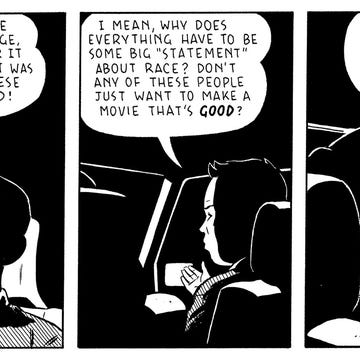I ’ve never seen a coyote. I’ve seen more people called coyotes than animals,” a nine-year-old Javier Zamora thinks when he happens upon a rotting coyote carcass in the California Book Club’s June selection, Solito. After excruciating days of battling thirst and weariness in the dry desert heat, Zamora, known as Chepito, and his fellow migrants from El Salvador, referred to in the book as the Six, stumble upon the wild canine, the animal from which migrant smugglers derive their name.
Although some believe that human coyotes got their name from the craftiness and trickery they employ to smuggle migrants across country lines, the name actually references the territories smugglers frequent, which animal coyotes regularly prowl. Zamora gives the human coyotes sobriquets: the nice coyote, the mean coyote, the old coyote, the bearded coyote, and the Mexican coyote. Zamora’s nine-year-old self could not have described them better. Where the nice coyote’s voice is calm, easing the child’s mind, the mean coyote deploys cruel insults, at one point yelling “¡Jump in! ¡Don’t be a bitch!” at a man who is frightened to jump into the ocean because he can’t swim.
Solito covers Zamora’s 3,000-mile trek from his hometown in El Salvador to where he currently lives, the western United States. One constant during these difficult weeks: that coyotes control his fate and that of the Six’s, for better or worse. Perceptions of and reactions to the smugglers swing from positive to negative throughout the memoir, at times landing on a nuanced mix of both emotional valences.
Before Zamora starts his journey, the local fruit vendor, La Chele Gloria, discusses Don Dago—known as “the best coyote in the central coast of El Salvador” but also someone with a history of sexual harassment. He is the same smuggler who initially refuses to take children younger than 10 yet doesn’t hesitate to cross criminals at the right price.
Beyond the events of the book, our country implements restrictive immigration policies that control who can enter through what port of entry, and finding an in-between port is where smugglers come in. And these real-life smugglers oftentimes don’t align with the stereotypical portrayal of a coyote.
“It’s often a very gendered, racialized portrayal of who is a smuggler. It’s often a Mexican man, and if you go back historically, it’s, like, this furtive Mexican man along the border who’s moving people in,” says Stephanie Leutert, the director of the Central America and Mexico Policy Initiative at the Robert S. Strauss Center for International Security and Law at the University of Texas at Austin. “And that’s just not what overall smuggling looks like at all right now. There’s a lot of different actors, especially on the U.S. side. Most people are U.S. citizens.”
In 2021, 75 percent of the people caught and convicted in a federal court for the crime of human smuggling were U.S citizens, and their demographics ranged from men experiencing homelessness to single mothers traveling with their children.
Human smuggling is not unique to the Mexico–United States border (although that region is the world’s largest migratory corridor). Smugglers are hired worldwide: in Afghanistan, Syria, Honduras, El Salvador, and Guatemala, among other countries. And most of their work happens almost unseen. A good coyote is one who is well-connected and develops contingency plans for the territory they are traversing: having a boat manned and ready to pull away from the shore, knowing a bus driver who is willing to travel with migrants, being aware of what cartel controls what area (and paying it off), locating a safe stash house, and knowing which border agents are content to look the other way.
At the U.S.-Mexico border, the better the coyote (and the easier the journey), the more expensive the trip can be. For example, $8,000 can buy passage with a smuggler through the desert heat, but more-luxurious forms of transportation—say, in a vehicle’s secret compartment, with U.S. immigration officers already paid to look the other way—run to around $20,000. And prices for these services are soaring: just last year, an average trip ranged from $12,000 to $14,000. It’s a lucrative business, and that’s why the number of coyotes ready to provide their services is not shrinking.
“There are people who are willing to take these risks,” says Leutert. “There’s always going to be someone else who’s going to try to step in because it’s money. And people are in circumstances where they need money.”
For as much as migrants pay, there is still no guarantee of safe travels. The reality of these illegal operations means that there is no legal channel through which to report mistreatment, abuse, or harassment—and these happen. The difference between a human smuggler and a human trafficker lies merely in whether the people being smuggled are willing or unwilling. Many trips end in kidnappings, extortion, and even death.
Migrants can take few actions to mitigate risks. Because smugglers like Don Dago often find work through a friend of a friend in a small town, they have more of an incentive to lead someone from their town across international borders safely than to lead someone who joined them on the last leg of the journey. The farther away from home a migrant is when hiring a coyote, the greater the risk they’re taking.
Nobody truly chooses to go on these trips. In most cases, it’s desperation that leads people to bear the enormous risks—and to ask their children to bear them, too. In recent years, the number of unaccompanied minors crossing borders has soared. In 2022, nearly 130,000 migrant children entered the country, the majority from Central America: thousands of Chepitos going through their own journeys and their own traumas.
“Why would people do this? Well, you’re lucky you’ve never been in a situation where your reality is such that this feels like a good option. A dad told me he left because he couldn’t listen to his kid telling him every day, ‘Can I have food? Can I have food?’ They didn’t have enough food. It’s the violence, it’s political, it’s a range of factors,” says Leutert when asked why someone would make this trip. “It’s hunger.”•
Join us on June 20 at 5 p.m. Pacific time, when Zamora will sit down with CBC host John Freeman and special guest Ingrid Rojas Contreras to discuss Solito. Register for the Zoom conversation here.
LEFT BEHIND
Michelle Cruz Gonzales considers the impacts of migration on family relationships. —Alta
CELEBRITY AND DEBAUCHERY
Karl Taro Greenfeld reviews Griffin Dunne’s The Friday Afternoon Club, about Dunne and his famous literary family, describing it as an “ode to the triumph of American adolescence.” —Alta
“THE FRIDAY AFTERNOON CLUB”
Read an excerpt from Griffin Dunne’s memoir. —Alta
PRINTFLUENCER
Author Jennifer Lewis profiles Liz Lapp, the owner of Hi Desert Times, a Twentynine Palms shop that regards itself as an oasis for print lovers and creative minds. —Alta
SAN JOSE EARTHQUAKES
Bay Area author Gary Singh will be at the Commonwealth Club on Tuesday, June 25, at 5:30 p.m. to discuss his stellar history of a beloved soccer team, The Unforgettable San Jose Earthquakes: Momentous Stories on and off the Field. —Commonwealth Club
LINGERING WOUNDS
Prior CBC author Rebecca Solnit writes about catastrophes we’ve faced in the past eight years. —Guardian
Alta’s California Book Club email newsletter is published weekly. Sign up for free and you also will receive four custom-designed bookplates.



















